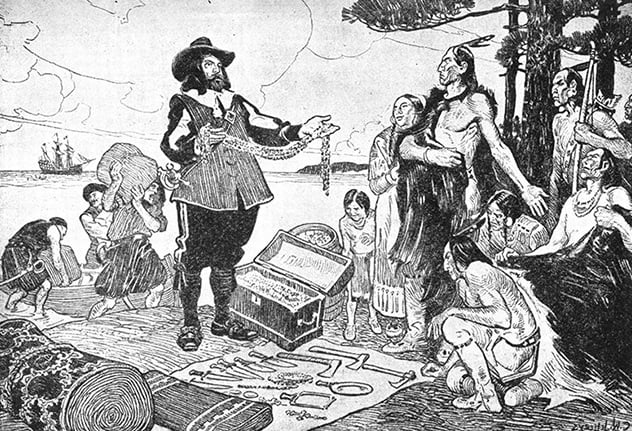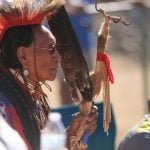Métis

While the first Native American-European fur trade exchange happened about the year 1000 with Norse (i.e. Viking) entrepreneurs from Greenland, the fur trade didn’t really have a major impact on Native cultures until the seventeenth and eighteenth centuries. The fur trade not only brought new goods into Indian nations, but also resulted in the emergence of a distinct cultural group known as Métis in Canada.
The French approach to American Indians was very different from that of the English, Spanish, and Russian invaders. The French viewed Indians as trading partners and potential markets for their goods. Instead of requiring their Indian partners to learn European ways as a prerequisite for trade, the French learned Indian ways.
Trade between nations was nothing new to American Indians: they had been engaged in trade for thousands of years by the time the French arrived. In what is now Canada, Indian trade involved both ceremonies and kinship. French traders understood this and became participants in the pipe ceremonies and gift giving that preceded formal trading. Since the French traders, all of whom were men, did not belong to any Indian clans, they had to acquire kinship connections through adoption and/or marriage.
Thus an important part of the French-Indian fur trade involved the marriage of the French fur traders into the Indian tribes. The French fur traders adopted many aspects of Indian culture and became as Indian as they were French. William Eccles, in his chapter on French exploration in North American Exploration. Volume 2: A Continent Defined, writes: “These marriage alliances were regarded favourably by the Indians, since they strengthened the bonds between the two races, but they were frowned on by the royal officials and the clergy, who maintained that the offspring of these marriages combined the worst features of both races.”
One of the consequences of marriage is often children. The children of these fur trade marriages grew up in bilingual, bicultural households and often became important players in the expanding fur trade. While the fathers were often French, there were also Scots and Irish traders who married Indian women. The mothers most frequently came from Algonquian-speaking tribes, most often Cree or Anishinaabe (Ojibwa). Historian Barry Gough, in his biography First Across the Continent: Sir Alexander Mackenzie, writes: “The descendants of these families became a distinct and important people in Canadian history, the Métis.”
Dan Asfar and Tim Chodan, in their biography Louis Riel, write: “The Métis were a French-speaking people living in western Canada who drew their ancestry from both whites and Natives. They were the offspring of French fur traders and Native women who married during traders’ sojourns in Rupert’s Land.”
Rupert’s Land refers to the area granted to Hudson’s Bay Company (HBC). Asfar and Chodan also report: “Over time, the Métis (French for “half-caste”) formed a distinct population. They developed buffalo-hunting practices of their own and competed against bordering Natives for hunting grounds.”
From the Native American perspective there was no such thing as race, and thus the Métis were not viewed as an interracial group. Culturally and linguistically, the Métis blended European and Native American features into a new culture. As with other indigenous people, there were a number of different Métis cultural variations. Josephine Paterek, in her book Encyclopedia of American Indian Costume, reports:“The Southern Métis were the offspring of the French coureurs de bois and Ojibway or Cree women; they were typically Catholic and lived in and around the Red River Valley. The Northern Métis, in the vicinity of the Saskatchewan River, were the offspring of Scottish and English traders and Athapaskan women and usually followed the Anglican religion.”
One of the characteristics of Métis men was the wearing of a red, finger-woven sash which was usually about 60 inches in length.
During the nineteenth century there were a number of conflicts between the British and the Métis. In 1814, for example, a conflict known as the Pemmican War broke out in Saskatchewan when the governor attempted to stop the pemmican trade.
After Rupert’s Land became a part of the Canadian Federation and was opened to homesteading, the Métis system of land distribution—narrow, river front lots—did not mesh with the Canadian homesteading squares. The Métis during the 1880s repeatedly petitioned Ottawa for official recognition of their lands and their concerns were ignored.
By the twentieth century, Canada recognized the Métis as a distinct people. In 1901, for example, the Canadian government offered land script to Métis who had been born between certain dates. As a result, many Canadian-born Metis returned to Canada from the United States.
In Canada today, the Métis are recognized as an indigenous people. The United States, with its obsession for race expressed in the concept of blood quantum, does not recognize the Métis.



